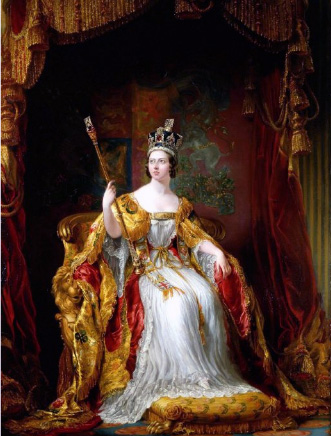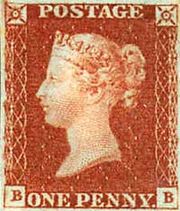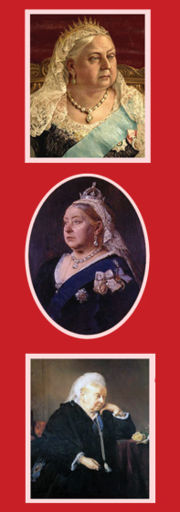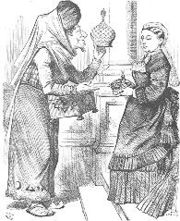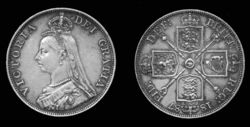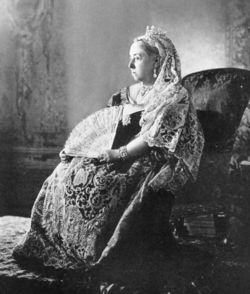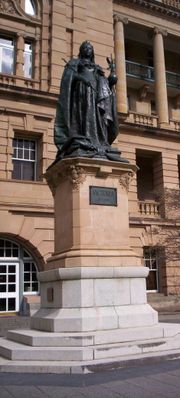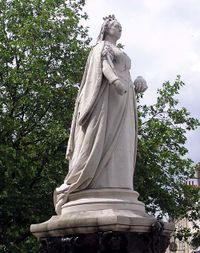Victoria of the United Kingdom
2007 Schools Wikipedia Selection. Related subjects: Historical figures
| Victoria | |
|---|---|
| Queen of the United Kingdom of Great Britain and Ireland. | |
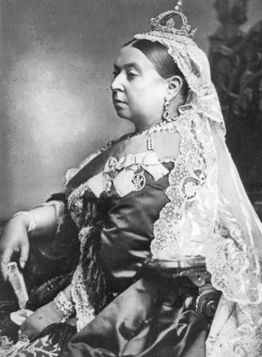 |
|
| Golden Jubilee Photograph | |
| Reign | 20 June 1837 - 22 January 1901 |
| Coronation | 28 June 1838 |
| Predecessor | William IV |
| Successor | Edward VII |
| Consort | Albert, Prince Consort |
| Issue | |
| Victoria, German Empress and Queen of Prussia Edward VII Alice, Grand Duchess of Hesse Alfred, Duke of Saxe-Coburg and Gotha Helena, Princess Christian of Schleswig-Holstein Louise, Duchess of Argyll Arthur, Duke of Connaught Leopold, Duke of Albany Beatrice, Princess Henry of Battenberg |
|
| Full name | |
| Alexandrina Victoria | |
| Titles | |
| HM The Queen HRH Princess Victoria of Kent |
|
| Royal House | House of Hanover |
| Royal anthem | God Save the Queen |
| Father | Edward Augustus, Duke of Kent |
| Mother | Victoria, Duchess of Kent |
| Born | 24 May 1819 Kensington Palace, London |
| Baptised | 24 June 1819 Kensington Palace, London |
| Died | 22 January 1901 Osborne House, Isle of Wight |
| Burial | 2 February 1901 Frogmore, Windsor |
Victoria (Alexandrina Victoria; 24 May 1819 – 22 January 1901) was the Queen of the United Kingdom of Great Britain and Ireland from 20 June 1837, and the first Empress of India from 1 January 1877, until her death in 1901. Her reign lasted more than sixty-three years, longer than that of any other British monarch. Victoria's reign was marked by a great expansion of the British Empire. The Victorian Era was at the height of the Industrial Revolution, a period of significant social, economic, and technological change in the United Kingdom. In that period the British Empire reached its zenith and became the formidable global power of the time.
Victoria, who was almost entirely of German descent (except from her ancestor Sophia of Hanover, who was a female-line granddaughter of James I), was the last monarch of the House of Hanover; her son King Edward VII belonged to the House of Saxe-Coburg and Gotha.
Early life
Victoria's father, the Duke of Kent and Strathearn, was the fourth son of King George III and Queen Charlotte. Her mother was Princess Victoria of Saxe-Coburg-Saalfeld. George III's eldest son, the Prince of Wales (the future King George IV), had only one child, Princess Charlotte Augusta of Wales. When she died in 1817, the remaining unmarried sons of King George III scrambled to marry and father children to guarantee the line of succession.
At the age of fifty the Duke of Kent and Strathearn married Princess Victoria of Saxe-Coburg-Saalfeld, the sister of Princess Charlotte's widower Prince Leopold of Saxe-Coburg-Saalfeld and widow of Karl, Prince of Leiningen. Victoria, the only child of the couple, was born in Kensington Palace, London on 24 May 1819. She was christened in the Cupola Room of Kensington Palace on 24 June 1819 by the Archbishop of Canterbury ( Charles Manners-Sutton), and her godparents were the Prince Regent, the Emperor Alexander I of Russia (in whose honour she received her first name), Queen Charlotte of Württemberg and the Dowager Duchess of Saxe-Coburg-Saalfeld.
Although christened Alexandrina Victoria, from birth she was formally styled Her Royal Highness Princess Victoria of Kent. She was called Drina within the family. Princess Victoria's father died of pneumonia eight months after she was born. Her grandfather, George III, died six days later. Princess Victoria's uncle, the Prince of Wales, inherited the Crown, becoming King George IV.
Though she occupied a high position in the line of succession, Victoria was taught only German, the first language of both her mother and her governess, during her early years. After reaching the age of three, however, she was schooled in English. She eventually learned to speak Italian, Greek, Latin, and French. Her educator was the Reverend George Davys and her governess was Louise Lehzen.
When Princess Victoria of Kent was eleven years old, King George IV died childless, leaving the throne to his brother, the Duke of Clarence and St Andrews, who became King William IV. Although he was the father of ten illegitimate children by his mistress, the actress Dorothy Jordan, the new king had no living legitimate children. Hence the young Princess Victoria became heiress presumptive. Since the law at that time made no special provision for a child monarch, Victoria would have been no less eligible to reign than an adult would. In order to prevent such a scenario, Parliament passed the Regency Act 1830, under which it was provided that Victoria's mother, the Duchess of Kent and Strathearn, would act as Regent during the queen's minority. Ignoring precedent, Parliament did not create a council to limit the powers of the Regent.
Princess Victoria met her future husband, Prince Albert of Saxe-Coburg and Gotha, when she was sixteen years old. Prince Albert was Victoria's first cousin; his father was her mother's brother. King William IV disapproved of the match, but his objections failed to dissuade the couple. Victoria had to propose to him because a man of even slightly lower social status was not allowed to propose to her. Many scholars have suggested that Prince Albert was not in love with young Victoria, and that he entered into a relationship with her in order to gain social status (he was a minor German prince) and out of a sense of duty (his family wanted the match). Whatever Albert's original reasons for marrying Victoria may have been, theirs proved to be an extremely happy marriage.
| British Royalty |
|---|
| House of Hanover |
 |
| George III |
| Grandchildren |
| Charlotte, Princess Leopold of Saxe-Coburg-Saalfield |
| Princess Elizabeth of Clarence |
| Victoria |
| George V, King of Hanover |
| George, Duke of Cambridge |
| Augusta, Grand Duchess of Mecklenburg-Strelitz |
| Mary Adelaide, Duchess of Teck |
| Victoria |
Early reign
On 24 May 1837 Victoria turned 18, meaning that a regency would not be necessary. Four weeks later, Victoria was awoken by her mother to find that at 12 minutes past 2 a.m. on 20 June 1837, William IV had died from heart failure at the age of seventy-one. Victoria was now Queen of the United Kingdom—however she did not inherit the throne of Hanover, a realm which had shared a monarch with Britain since 1714. Hanover had been given a constitution in 1833 that implied the Welf heritage law that if there was no male heir to the king, the Welf line of Brunswick-Wolfenbüttel would inherit the realm of Hanover (kingdom since 1806). Only after that line would a woman have been able to inherit the throne.
Victoria remained a Princess of Hanover and a Duchess of Brunswick and Lunenburg throughout her life, but the crown of Hanover went to her uncle the Duke of Cumberland and Teviotdale, who became King Ernest Augustus I of Hanover. As the young queen was as yet unmarried and childless, Ernest Augustus also remained the heir presumptive to the throne of the United Kingdom until her first child was born in 1840.
When Victoria ascended the throne, the government was controlled by the Whig Party, which had been in power, except for brief intervals, since 1830. The Whig Prime Minister, Lord Melbourne, at once became a powerful influence in the life of the politically inexperienced Queen, who relied on him for advice. (Some even referred to Victoria as "Mrs. Melbourne".) The Melbourne ministry would not stay in power for long; it was growing unpopular and, moreover, faced considerable difficulty in governing the British colonies. In Canada, the United Kingdom faced an insurrection (see Rebellions of 1837), and in Jamaica, the colonial legislature had protested British policies by refusing to pass any laws. In 1839, unable to cope with the problems overseas, the ministry of Lord Melbourne resigned.
The Queen commissioned Sir Robert Peel, a Tory, to form a new ministry, but was faced with a debacle known as the Bedchamber Crisis. At the time, it was customary for appointments to the Royal Household to be based on the patronage system (that is, for the Prime Minister to appoint members of the Royal Household on the basis of their party loyalties). Many of the Queen's Ladies of the Bedchamber were wives of Whigs, but Sir Robert Peel expected to replace them with wives of Tories. Victoria strongly objected to the removal of these ladies, whom she regarded as close friends rather than as members of a ceremonial institution. Sir Robert Peel felt that he could not govern under the restrictions imposed by the Queen, and consequently resigned his commission, allowing Melbourne to return to office.
Marriage
The Queen married her first cousin, Prince Albert on 10 February 1840, at the Chapel Royal in St. James's Palace; four days before, Victoria granted her husband, who was born the same year as herself, the style His Royal Highness. Prince Albert was commonly known as the Prince Consort, though he did not formally obtain the title until 1857. Prince Albert was never granted a peerage dignity. Albert was not only the Queen's companion, but also an important political advisor, replacing Lord Melbourne as the dominant figure in her life.
During Victoria's first pregnancy, eighteen-year old Edward Oxford attempted to assassinate the Queen while she was riding in a carriage with Prince Albert in London. Oxford fired twice, but both bullets missed. He was tried for high treason, but was acquitted on the grounds of insanity. His plea was questioned by many; Oxford may merely have been seeking notoriety. Many suggested that a Chartist conspiracy was behind the assassination attempt; others attributed the plot to supporters of the heir presumptive, King Ernest Augustus of Hanover. These conspiracy theories produced a wave of patriotism and loyalty within the country.
The shooting had no effect on the Queen's health or on her pregnancy. The first of the royal couple's nine children, named Victoria, was born on 21 November 1840.
When the Whigs under Melbourne lost the elections of 1841 and were replaced by the Tories under Peel, there was no repeat of the Bedchamber Crisis. Victoria continued to secretly correspond with Lord Melbourne, whose influence, however, faded away as that of Prince Albert increased.
On 13 June 1842, Victoria made her first journey by train, travelling from Slough railway station (near Windsor Castle) to Bishop's Bridge, near Paddington (in London), in a special royal carriage provided by the Great Western Railway. Accompanying her were her husband and the engineer of the Great Western line, Isambard Kingdom Brunel.
Three attempts to assassinate Queen Victoria occurred in 1842. On 29 May at St. James's Park, John Francis (most likely seeking to gain notoriety) fired a pistol at the Queen (then in a carriage), but was immediately seized by Police Constable William Trounce. Francis was convicted of high treason, but his death sentence was commuted to transportation for life.
Prince Albert felt that the attempts were encouraged by Oxford's acquittal in 1840. On 3 July, just days after Francis' sentence was commuted, another boy, John William Bean, attempted to shoot the Queen. Although his gun was loaded only with paper and tobacco, his crime was still punishable by death. Feeling that such a penalty would be too harsh, Prince Albert encouraged Parliament to pass the Treason Act of 1842, under which aiming a firearm at the Queen, striking her, throwing any object at her, and producing any firearm or other dangerous weapon in her presence with the intent of alarming her, were made punishable by seven years imprisonment and flogging. Bean was thus sentenced to eighteen months imprisonment; however, neither he, nor any person who violated the act in the future, was flogged.
Surname
Victoria belonged to the House of Hanover. Although some assign the surname d' Este or the surname Welf to her, she never needed to use any surname (some other descendants of the House of Hanover have used the surname Hanover in Britain). Her husband belonged to the House of Saxe-Coburg and Gotha and accordingly at Victoria's death, that House ascended the British throne in the person of her son and heir Edward VII - according to custom of nobles and royals, a wife never gains the membership of her husband's house, but remains as belonging to her own and thus Victoria was not of the House of Saxe-Coburg and Gotha. As a married woman, most genealogists assign to her the surname von Wettin, based on the advice of the College of Arms. She is therefore sometimes referred to as it Alexandrina Victoria von Wettin, née Hanover.
While Albert was of the House of Saxe-Coburg and Gotha, the German house was descended from the Ernestine Branch of the Wettin dynasty. Victoria asked her staff to determine what Albert's and now her own marital surname was. After examining records from the Saxe-Coburg-Gotha archives, they reported that her husband's personal surname, as was the case with other members of both the Ernestine and Albertine branches, was Wettin (or von Wettin). Queen Victoria's papers record her dislike of the name.
Her grandson, George V, again explored the issue when changing both the surname and Royal House name in 1917 to Windsor. The College of Arms again informed him that his family surname prior to the change was Wettin. In the 1958 an Order-in-Council adapted the 1917 decision by granting some of Queen Elizabeth II's descendants the surname Mountbatten-Windsor. This does not apply to the Prince of Wales or either of his sons, but only to those descendants of the Queen and Prince Philip who never come to the throne. By statute, 'all' reigning sovereigns from 1917 onward bear the surname "Windsor," whether they were born with it or not.
Early Victorian politics
Peel's ministry faced a crisis involving the repeal of the Corn Laws (grain import tariffs). Many Tories (by then known also as Conservatives) were opposed to the repeal, but some Tories (the "Peelites") and most Whigs supported it. Peel resigned in 1846, after the repeal narrowly passed, and was replaced by Lord John Russell. Russell's ministry, though Whig, was not favoured by the Queen. Particularly offensive to Victoria was the Foreign Secretary, Lord Palmerston, who often acted without consulting the Cabinet, the Prime Minister, or the Queen.
In 1849, Victoria lodged a complaint with Lord John Russell, claiming that Palmerston had sent official dispatches to foreign leaders without her knowledge. She repeated her remonstrance in 1850, but to no avail. It was only in 1851 that Lord Palmerston was removed from office; he had on that occasion announced the British government's approval for President Louis-Napoleon Bonaparte's coup in France without previously consulting the Prime Minister.
The period during which Russell was prime minister also proved personally distressing to Queen Victoria. In 1849, an unemployed and disgruntled Irishman named William Hamilton attempted to alarm the Queen by firing a powder-filled pistol as her carriage passed along Constitution Hill, London. Hamilton was charged under the 1842 act; he pleaded guilty and received the maximum sentence of seven years of penal transportation. In 1850, the Queen did sustain injury when she was assaulted by a possibly insane ex-Army officer, Robert Pate. As Victoria was riding in a carriage, Pate struck her with his cane, crushing her bonnet and bruising her. Pate was later tried; he failed to prove his insanity, and received the same sentence as Hamilton.
Ireland
The young Queen Victoria fell in love with Ireland, choosing to holiday in Killarney in Kerry, in the process launching the location as one of the nineteenth century's prime tourist locations. Her love of the island was matched by initial Irish warmth towards the young Queen. In 1845, Ireland was hit by a potato blight that over four years cost the lives of over one million Irish people and saw the emigration of another million. In response to what came to be called the Irish Potato Famine (An Gorta Mor), the Queen personally donated (5000 pounds sterling) to the starving Irish people.
The policies of her minister Lord John Russell were widely blamed for exacerbating the severity of the famine, killing a million Irishmen, which adversely affected the Queen's popularity in Ireland. There was more than enough food produced in Ireland during the famine, but most of it was exported by the British land owners, leaving the Irish people to die with green mouths from eating grass during their last days of starvation.
Victoria was a strong supporter of the Irish. She supported the Maynooth Grant and made a point, on visiting Ireland, of visiting the seminary.
Victoria's first official visit to Ireland, in 1849, was specifically arranged by Lord Clarendon, the Lord Lieutenant of Ireland, the head of the British administration, to try both to draw attention off the famine and also to alert British politicians through the Queen's presence to the seriousness of the crisis in Ireland. Notwithstanding the negative impact of the famine on the Queen's popularity, she still remained sufficiently popular for nationalists at party meetings to finish by singing God Save the Queen.
However by the 1870s and 1880s the monarchy's appeal in Ireland had diminished substantially, partly as a result of Victoria's decision to refuse to visit Ireland in protest at the decision of Dublin Corporation to refuse to congratulate her son, the Prince of Wales, on his marriage to Princess Alexandra of Denmark, or to congratulate the royal couple on the birth of their oldest son, Prince Albert Victor.
Victoria refused repeated pressure from a number of prime ministers, lords lieutenant and even members of the Royal Family, to establish a royal residence in Ireland. Lord Midleton, the former head of the Irish unionist party, writing in his memoirs of 1930 Ireland: Dupe or Heroine?, described this decision as having proved disastrous to the monarchy and British rule in Ireland.
Victoria paid her last visit to Ireland in 1900, when she came to appeal to Irishmen to join the British Army and fight in the Second Boer War. Nationalist opposition to her visit was spearheaded by Arthur Griffith, who established an organisation called Cumann na nGaedheal to unite the opposition. Five years later Griffith used the contacts established in his campaign against the queen's visit to form a new political movement, Sinn Fein.
In 1851, the first World Fair, known as the Great Exhibition of 1851, was held. Organised by Prince Albert, the exhibition was officially opened by the Queen on 1 May 1851. Despite the fears of many, it proved an incredible success, with its profits being used to endow the South Kensington Museum (later renamed the Victoria and Albert Museum).
Lord John Russell's ministry collapsed in 1852, when the Whig Prime Minister was replaced by a Conservative, Lord Derby. Lord Derby did not stay in power for long, for he failed to maintain a majority in Parliament; he resigned less than a year after entering office. At this point, Victoria was anxious to put an end to this period of weak ministries. Both the Queen and her husband vigorously encouraged the formation of a strong coalition between the Whigs and the Peelite Tories. Such a ministry was indeed formed, with the Peelite Lord Aberdeen at its head.
One of the most significant acts of the new ministry was to bring the United Kingdom into the Crimean War in 1854, on the side of the Ottoman Empire and against Russia. Immediately before the entry of the United Kingdom, rumours that the Queen and Prince Albert preferred the Russian side diminished the popularity of the royal couple. Nonetheless, Victoria publicly encouraged unequivocal support for the troops. The year after the end of the war, she instituted the Victoria Cross, an award for valour.
His management of the war in the Crimea questioned by many, Lord Aberdeen resigned in 1855, to be replaced by Lord Palmerston, with whom the Queen had reconciled. Palmerston too was forced out of office due to the unpopular conduct of a military conflict, the Second Opium War, in 1857. He was replaced by Lord Derby. Amongst the notable events of Derby's administration was the Sepoy Mutiny against the rule of the British East India Company over India. After the mutiny was crushed, India was put under direct British rule (though the title "Empress of India" was not instituted immediately). Derby's second ministry fared no better than his first; it fell in 1859, allowing Palmerston to return to power.
Widowhood
The Prince Consort died on 14 December 1861, devastating Victoria, who entered a semi-permanent state of mourning and wore black for the remainder of her life. She avoided public appearances and rarely set foot inside London in the following years, her seclusion earning her the nickname "Widow of Windsor". She regarded her son, the Prince of Wales, as an indiscreet and frivolous youth, blaming him for his father's death.
Victoria began to increasingly rely on a Scottish manservant, John Brown; and a romantic connection and even a secret marriage have been alleged, but are generally discredited. A passage in an article from Petronella Wyatt for the Daily Mail ( September 02, 2006) refers that her late father, Woodrow Wyatt, met Elizabeth Bowes-Lyon, the Queen Mother, in the Eighties and she came frequently to their house for lunch and dinner. In one of those occasions, the conversation turned to Queen Victoria and John Brown. The Queen Mother claimed she found documents in the royal archives at Windsor suggesting they had married. Asked what she had done about the discovery, she said she burned the documents. .
One recently discovered diary records a supposed deathbed confession by the Queen's private chaplain in which he admitted to a politician that he had presided over a clandestine marriage between Victoria and John Brown. Not all historians trust the reliability of the diary. However, when Victoria's corpse was laid in its coffin, two sets of mementos were placed with her, at her request. By her side was placed one of Albert's dressing gowns while in her left hand was placed a piece of Brown's hair, along with a picture of him. Rumours of an affair and marriage earned Victoria the nickname "Mrs Brown". The story of their relationship was the subject of the movie Mrs. Brown.
Victoria's isolation from the public greatly diminished the popularity of the monarchy, and even encouraged the growth of the republican movement. Although she did perform her official duties, she did not actively participate in the government, remaining secluded in her royal residences, Balmoral in Scotland or Osborne House on the Isle of Wight. Meanwhile, one of the most important pieces of legislation of the nineteenth century — the Reform Act 1867 — was passed by Parliament. Lord Palmerston was vigorously opposed to electoral reform, but his ministry ended upon his death in 1865. He was followed by Earl Russell (the former Lord John Russell), and afterwards by Lord Derby, during whose ministry the Reform Act was passed.
Gladstone and Disraeli
In 1868, the Conservative Benjamin Disraeli entered office. He would later prove to be Victoria's favourite Prime Minister. His ministry, however, soon collapsed, and he was replaced by William Ewart Gladstone, a member of the Liberal Party (as the Whig-Peelite Coalition had become known). Gladstone was famously at odds with both Victoria and Disraeli during his political career. She once remarked that she felt he addressed her as though she were a public meeting. The Queen disliked Gladstone, as well as his policies, as much as she admired Disraeli. It was during Gladstone's ministry, in the early 1870s, that the Queen began to gradually emerge from a state of perpetual mourning and isolation. With the encouragement of her family, she became more active.
In 1872, Victoria endured her sixth encounter involving a gun. As she was alighting from a carriage, a seventeen-year old Irishman, Arthur O'Connor, rushed towards her with a pistol in one hand and a petition to free Irish prisoners in the other. The gun was not loaded; the youth's aim was most likely to alarm Queen Victoria into accepting the petition. John Brown, who was at the Queen's side, knocked the boy to the ground before Victoria could even view the pistol; he was rewarded with a gold medal for his bravery. O'Connor was sentenced to penal transportation and to corporal punishment, as allowed by the Act of 1842, but Victoria remitted the latter part of the sentence.
Disraeli returned to power in 1874, at which time an imperialist sentiment was espoused by many in the country, including the new Prime Minister and the Queen, as well as many in Europe. In 1871 the German Empire had been proclaimed, and Vicky, Victoria's eldest daughter, was married to its heir. This meant the daughter would someday become an Empress consort, appearing to outrank her far more powerful mother the Queen.
To prevent such a diplomatic anomaly, the Royal Titles Act 1876 gave the Queen the additional title "Empress of India". Victoria rewarded her Prime Minister, accelerating the customary award of an Earldom to a former prime minister, by creating him Earl of Beaconsfield while he was still in office.
Lord Beaconsfield's administration fell in 1880 when the Liberals won the general election of that year. Gladstone had relinquished the leadership of the Liberals four years earlier and the Queen invited Lord Hartington, Liberal leader in the Commons, to form a ministry. However Lord Hartington declined the opportunity, arguing that no Liberal ministry could work without Gladstone and he would serve under no one else. Victoria could do little but appoint Gladstone Prime Minister.
The last of the series of attempts on Victoria's life came in 1882. A Scottish madman, Roderick McLean, fired a bullet towards the Queen, then seated in her carriage, but he missed. Since 1842, each individual who attempted to attack the Queen had been tried for a misdemeanour (punishable by seven years of penal servitude), but McLean was tried for high treason (punishable by death). He was acquitted, having been found insane, and was committed to an asylum. Victoria expressed great annoyance at the verdict of "not guilty, but insane", and encouraged the introduction of the verdict of "guilty, but insane" in the following year.
Victoria's conflicts with Gladstone continued during her later years. She was forced to accept his proposed electoral reforms, including the Representation of the People Act 1884, which considerably increased the electorate. Gladstone's government fell in 1885, to be replaced by the ministry of a Conservative, Lord Salisbury. Gladstone returned to power in 1886, and he introduced the Irish Home Rule Bill, which sought to grant Ireland a separate legislature. Victoria was opposed to the bill, which she believed would undermine the British Empire. When the bill was rejected by the House of Commons, Gladstone resigned, allowing Victoria to appoint Lord Salisbury to resume the premiership.
Later years
In 1887, the United Kingdom celebrated Victoria's Golden Jubilee. Victoria marked the fiftieth anniversary of her accession, 20 June 1887, with a banquet to which fifty European kings and princes were invited. Although she could not have been aware of it, there was a plan - ostensibly by Irish freedom fighters - to blow up Westminster Abbey while the Queen attended a service of thanksgiving. This assassination attempt, when it was discovered, became known as The Jubilee Plot. On the next day, she participated in a procession that, in the words of Mark Twain, "stretched to the limit of sight in both directions". At the time, Victoria was an extremely popular monarch. The scandal of a rumoured relationship with her servant had been quieted following John Brown's death in 1883, allowing the Queen to be perceived as a symbol of morality.
Victoria was required to tolerate a ministry of William Ewart Gladstone one more time, in 1892. After the last of his Irish Home Rule Bills was defeated, he retired in 1894, to be replaced by the Imperialist Liberal Lord Rosebery. Lord Rosebery was succeeded in 1895 by Lord Salisbury, who served for the remainder of Victoria's reign.
On 22 September 1896, Victoria surpassed George III as the longest reigning monarch in English, Scottish, and British history. The Queen requested all special public celebrations of the event to be delayed until 1897, to coincide with her Diamond Jubilee. The Colonial Secretary, Joseph Chamberlain, proposed that the Jubilee be made a festival of the British Empire.
Thus, the Prime Ministers of all the self-governing colonies were invited along with their families. The procession in which the Queen participated included troops from each British colony and dependency, together with soldiers sent by Indian Princes and Chiefs (who were subordinate to Victoria, the Empress of India). The Diamond Jubilee celebration was an occasion marked by great outpourings of affection for the septuagenarian Queen, who was by then confined to a wheelchair.
It is thought by some historians, though, that Queen Victoria wore a white dress only for her Diamond Jubilee celebration, abandoning the black she wore continuously since the death of her husband.
During Victoria's last years, the United Kingdom was involved in the Second Boer War, which received the enthusiastic support of the Queen. Victoria's personal life was marked by many personal tragedies, including the death of her son, the Duke of Saxe-Coburg and Gotha, the fatal illness of her daughter, The Empress Friedrich, Queen Dowager of Prussia, and the death of two of her grandsons, Prince Alfred of Edinburgh and Saxe-Coburg-Gotha and Prince Christian Victor of Schleswig-Holstein. Her last ceremonial public function came in 1899, when she laid the foundation stone for new buildings of the South Kensington Museum, which became known as the Victoria and Albert Museum.
Death
Following a custom she maintained throughout her widowhood, Victoria spent Christmas in Osborne House (which Prince Albert had designed) on the Isle of Wight. She died there from a cerebral haemorrhage on 22 January 1901, at the age of 81. As she had wished, her own sons lifted her into the coffin, where she was dressed in a white dress and her wedding veil. Her funeral occurred on 2 February, and after two days of lying-in-state, she was interred beside Prince Albert in the Frogmore Mausoleum in Windsor Castle. Because Victoria had a dislike for black funerals, London was instead festooned in purple and white. Victoria had reigned for a total of 63 years, seven months and two days - the longest reign in British history
Succession
Victoria was succeeded by her eldest son, The Prince of Wales,as King Edward VII. Victoria's death brought an end to the rule of the House of Hanover in the United Kingdom. Edward VII belonged to the House of Saxe-Coburg and Gotha, inherited from his father Prince Albert.
Titles, styles, honours and arms
Titles
- 1819-1837: Her Royal Highness Princess Victoria of Kent
- 1837-1901: Her Majesty The Queen
and, occasionally, outside of the United Kingdom, and with regard to India
- 1876-1901: Her Imperial Majesty The Queen-Empress
As the male-line granddaughter of a King of Hanover, Victoria also bore the titles of Princess of Hanover and Duchess of Brunswick and Lunenburg. In addition, she held the titles of Princess of Saxe-Coburg and Gotha and Duchess in Saxony as the wife of Prince Albert.
Arms
Victoria's arms were: Quarterly, I and IV Gules three lions passant guardant in pale Or (for England); II Or a lion rampant within a double tressure flory-counter-flory Gules (for Scotland); III Azure a harp Or stringed Argent (for Ireland). These same arms have been used by every subsequent British monarch.
Issue
| Name | Birth | Death | Notes |
|---|---|---|---|
| The Princess Victoria, Princess Royal | 21 November 1840 | 5 August 1901 | married 1858, Friedrich III, German Emperor and King of Prussia; had issue |
| King Edward VII | 9 November 1841 | 6 May 1910 | married 1863, Princess Alexandra of Denmark; had issue |
| The Princess Alice | 25 April 1843 | 14 December 1878 | married 1862, Ludwig IV, Grand Duke of Hesse and by Rhine; had issue |
| The Prince Alfred, Duke of Saxe-Coburg and Gotha and Duke of Edinburgh | 6 August 1844 | 31 July 1900 | married 1874, Grand Duchess Marie Alexandrovna of Russia; had issue |
| The Princess Helena | 25 May 1846 | 9 June 1923 | married 1866, Prince Christian of Schleswig-Holstein-Sonderburg-Augustenburg; had issue |
| The Princess Louise | 18 March 1848 | 3 December 1939 | married 1871, John Douglas Sutherland Campbell, 9th Duke of Argyll; no issue |
| The Prince Arthur, Duke of Connaught and Strathearn | 1 May 1850 | 16 January 1942 | married 1879, Princess Louise Margarete of Prussia; had issue |
| The Prince Leopold, Duke of Albany | 7 April 1853 | 28 March 1884 | married 1882, Princess Helena of Waldeck and Pyrmont; had issue |
| The Princess Beatrice | 14 April 1857 | 26 October 1944 | married 1885, Prince Henry of Battenberg; had issue |
Ancestors
|
Victoria of the United Kingdom |
Father: |
Father's father: George III of the United Kingdom |
Father's father's father: Frederick, Prince of Wales |
| Father's father's mother: Augusta of Saxe-Gotha |
|||
| Father's mother: Charlotte of Mecklenburg-Strelitz |
Father's mother's father: Carl Luis Frederick of Mecklenburg |
||
| Father's mother's mother: Princess Elizabeth Albertine of Saxe-Hildburghausen |
|||
| Mother: Victoria of Saxe-Coburg-Saalfeld |
Mother's father: Francis Frederick of Saxe-Coburg-Saalfeld |
Mother's father's father: Ernst Friedrich, Duke of Saxe-Coburg-Saalfeld |
|
| Mother's father's mother: Sofie Antonie of Braunschweig-Wolfenbüttel |
|||
| Mother's mother: Augusta of Reuss-Ebersdorf |
Mother's mother's father: Heinrich XXIV of Reuss-Ebersdorf |
||
| Mother's mother's mother: Karoline Ernestine of Erbach-Schönberg |
Legacy
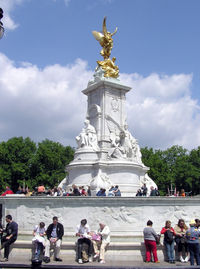
Queen Victoria was Britain's first modern monarch. Previous monarchs had been active players in the process of government. A series of legal reforms saw the House of Commons' power increase, at the expense of the Lords and the monarchy, with the monarch's role becoming more symbolic. Since Victoria's reign the monarch has had, in Walter Bagehot's words, "the right to be consulted, the right to advise, and the right to warn".
As Victoria's monarchy became more symbolic than political, it placed a strong emphasis on morality and family values, in contrast to the sexual, financial and personal scandals that had been associated with previous members of the House of Hanover and which had discredited the monarchy. Victoria's reign created for Britain the concept of the 'family monarchy' with which the burgeoning middle classes could identify.
Internationally Victoria was a major figure, not just in image or in terms of Britain's influence through the empire, but also because of family links throughout Europe's royal families, earning her the affectionate nickname "the grandmother of Europe". An example of that status can be seen in the fact that three of the main monarchs with countries involved in the First World War on the opposing side were themselves either grandchildren of Victoria's or married to a grandchild of hers. Eight of Victoria's nine children married members of European royal families, and the other, Princess Louise, married the first Governor General of Canada.
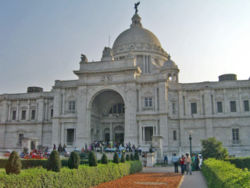
Victoria was the first known carrier of haemophilia in the royal line, but it is unclear how she acquired it. It may have been a result of a sperm mutation, her father having been fifty-two years old when Victoria was conceived. It had also been rumoured that the Duke of Kent was not the biological father of Victoria, and that she was in fact the daughter of her mother's Irish-born private secretary and reputed lover, Sir John Conroy. While there is some evidence as to the allegation of a relationship between the duchess and Conroy (Victoria herself claimed to the Duke of Wellington to have witnessed an incident between them), Conroy's medical history shows no evidence of the existence of haemophilia in his family, nor is it normally passed on the male side of the family.
It is much more likely that she acquired it from her mother, though there is no known history of haemophilia in her maternal family. Victoria herself did not suffer from the disease, however, she passed it on to Princess Alice and Princess Beatrice as carriers, and Prince Leopold was affected with the disease. The most famous haemophilia victim among her descendants was her great-grandson, Alexei, Tsarevich of Russia. However, Victoria's line of haemophilia has now probably been eliminated. There could still be a surviving branch in the royal family of Spain, but, as of 2005, the disease had not surfaced.
As of 2005, the European monarchs and former monarchs descended from Victoria are: the Queen of the United Kingdom (as well as her husband), the King of Norway, the King of Sweden, the Queen of Denmark, the King of Spain, the King of the Hellenes (deposed) and the King of Romania (deposed). The pretenders to the thrones of Serbia, Russia, Prussia and Germany, Saxe-Coburg and Gotha, Hanover, Hesse, and Baden are also descendants.
Queen Victoria experienced unpopularity during the first years of her widowhood, but afterwards became extremely well-liked during the 1880s and 1890s. In 2002, the British Broadcasting Corporation conducted a poll regarding the 100 Greatest Britons; Victoria attained the eighteenth place.
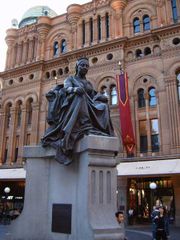
The statue stood outside the Irish parliament building, Leinster House until 1947.
Innovations of the Victorian era include postage stamps, the first of which—the Penny Black (issued 1840)—featured an image of the Queen, and the railway, which Victoria was the first British Sovereign to ride.
Several places in the world have been named after Victoria, including two Australian States ( Victoria and Queensland), the capitals of British Columbia and Saskatchewan, Canada, the capital of the Seychelles, Africa's largest lake, and Victoria Falls. See also List of places named after Queen Victoria.
Queen Victoria remains the most commemorated British monarch in history, with statues to her erected throughout the former territories of the British Empire. These range from the prominent, such as the Victoria Memorial outside Buckingham Palace, which was erected as part of the remodelling of the façade of the Palace a decade after her death, to the obscure: in the town of Cape Coast, Ghana, a bust of the Queen presides, rather forlornly, over a small park where goats graze around her. Many institutions, thoroughfares, parks, and structures bear her name. See also Victoria (disambiguation).
Post-colonial sensitivities have led to the removal of Victoria's image and name from some of these legacies. For instance, the statue of Queen Victoria sculpted by Irishman John Hughes erected in front of Leinster House in Dublin in 1924, was removed in 1947 after years of criticism that it was inappropriate to have the British Queen's likeness stand in front of the Oireachtas, the parliament of the Irish Free State. After decades in storage the statue was given by the Republic of Ireland to Australia and unveiled on 20 December 1987 to stand outside the Queen Victoria Building in the centre of Sydney.
Trivia
- Queen Victoria publicly praised and used the fashionable 19th century cocaine-based drink Vin Mariani that later inspired Coca-Cola. The drink was also praised by Popes Leo XIII and Saint Pius X
- Of the current line of succession to the British throne, the first 510 people listed are descended from Victoria
- She became a grandmother at 39 and a great-grandmother at 59
- She died in the arms of her first grandchild, the German Emperor William II
- She outlived three of her nine children and came within seven months of outliving a fourth (her eldest daughter, Vicky, who died in August, 1901)
- She outlived eleven of her 42 grandchildren
- She outlived three of her 88 great-grandchildren
- As of November 2006, there were two surviving great-grandchildren of Queen Victoria: Count Carl Johan Bernadotte of Sweden and Lady Katherine Brandram
- Queen Victoria became the de facto first Queen of Canada. The Dominion of Canada was created in 1867, during the reign of Queen Victoria, making her Canada's first sovereign
- The Royal Military College of Canada was founded in 1874 and opened two years later. In 1878 Queen Victoria conferred the title, "Royal"
- Queen Victoria took on the title Empress of India in 1876, officially becoming the first British Monarch to rule India
- She was the first Queen of Australia. The Commonwealth of Australia was confederated on 1 January 1901, only 21 days before her death
- Her first act after coming to the throne was to remove her bed from her mother's room
- Every day for forty years after her Prince Consort had died, the Queen ordered that his clothes be laid afresh on his bed in his suite at Windsor Castle
- Queen Victoria was the only world leader to respond positively to messages that were sent to 19th century monarchs by Bahá'u'lláh, the Prophet-Founder of the Bahá'í Faith, inviting them to establish the " Most Great Peace". Out of all the empires addressed, hers - albeit in a lessened form - is the only empire that still remains
- Queen Victoria started the tradition of a bride wearing a white dress at her wedding. Before Victoria's wedding a bride would wear her best dress of no particular colour
- The queen and all her female-line descendants are known to be members of mitochondrial haplogroup H
- She was the first British monarch to be photographed
- She surpassed her grandfather King George III as the longest lived British monarch when she reached the age of 81 years and 240 days on 19 January 1901, only three days before her death
- One of her favourite books was The Strange Case of Dr Jekyll and Mr Hyde
